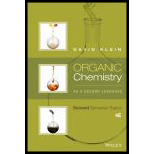
Concept explainers
Want to see the full answer?
Check out a sample textbook solution
Chapter 4 Solutions
Organic Chemistry As a Second Language: Second Semester Topics
Additional Science Textbook Solutions
Elementary Principles of Chemical Processes, Binder Ready Version
General Chemistry: Principles and Modern Applications (11th Edition)
Chemistry: A Molecular Approach (4th Edition)
Fundamentals of Heat and Mass Transfer
Chemistry: An Introduction to General, Organic, and Biological Chemistry (13th Edition)
Organic Chemistry
- Alkynes do not react directly with aqueous acid as do alkenes, but will do so in the presence of mercury(II) sulfate as a Lewis acid catalyst. The reaction occurs with Markovnikov regiochemistry, so the OH group adds to the more highly substituted carbon and the H adds to the less highly substituted carbon. The initial product of the reaction is a vinyl alcohol, also called an enol. The enol immediately rearranges to a more stable ketone via tautomerization. Draw curved arrows to show the movement of electrons in this step of the mechanism. Arrow-pushing Instructions -X티 Hö: H-O -CH3 -CH3 H30*arrow_forwardConsider the compound below, with all its carbons labeled. In reality we might predict that the alkene groups are more reactive to electrophiles, but instead imagine that an electrophile binds to carbon five as the first step of an electrophilic aromatic substitution mechanism. A carbocation results, with multiple resonance structures. Select every carbon that bears a positive charge in one of these resonance structures. 10 Carbon 1 O Carbon 2 Carbon 3 OCarbon 4 OCarbon 5 OCarbon 6 Carbon 7 Carbon 8 Carbon 9 Oerboi 10.arrow_forwardThe following reaction gives a mixture of the nucleophilic substitution (SN1 or SN2) and elimination (E1 or E2) products. Propose two mechanisms that can account for the formation of these products. One mechanism should be for the nucleophilic substitution reaction and the other mechanism would show the elimination reaction.arrow_forward
- You are planning to carry out a reaction between propyne, CH3C≡CH and sodium amide, NaNH2. You also need to choose an appropriate solvent for carrying out the reaction. Would ethanol be suitable for this purpose? Explain your rationale clearly.arrow_forwardmethanol + CH3OH Suppose you were told that the above reaction was a substitution reaction but you were not told the mechanism. Evaluate the following categories to determine the reaction mechanism and then draw the structure of the major organic product. Type of alkyl halide: Type of nucleophile: Solvent: Is the product racemic?arrow_forwardDescribe the mechanism by which benzene is converted to bromobenzene (C6H5Br) on treatment with a mixture of bromine and iron (III) bromide (Br2/FeBr3). Your answer should illustrate how the electrophile (Br*) is formed from the Br₂/FeBr3 and how it is involved in the electrophilic substitution of the aromatic ring.arrow_forward
- In attempting to make 2-bromo-2-methyl-propane from 2-methyl-propene, as shown below, you used a dilute aqueous solution of hydrobromic acid. Upon analysis of the isolated product, you realize there is a major unwanted by-product. Br a) Based on the reaction conditions used, predict the major by-product and show a mechanism for its formation. b) What should be changed in the reaction conditions described in order to completely avoid the formation of the unwanted by-product?arrow_forwardIn the experiment where an Electrophillic aromatic substitution sulfonation reaction is conducted on Indigo to produce the food dye FD&C Blue #2(indigo blue or indigotine). show a mechanism showing a single sulfonation on a molecule of indigo.arrow_forwardWhen ethoxybenzene is treated with a mixture of nitric acid and sulfuric acid, two products are obtained, each of which has the molecular formula C8H9NO3. For the mechanism, draw the curved arrows as needed. Include lone pairs and charges in your answer. Do not draw out any hydrogen explicitly in your products. Do not use abbreviations such as Me or Ph.arrow_forward
- Amines can be made by the reduction of nitriles, which in turn can be made from an alkyl halide. Draw the structures of a starting alkyl bromide and the intermediate nitrile that would be used in the synthesis of 3-methylbutylamine (also known as isoamylamine). Do not show free ions. alkyl bromide NC- nitrile Draw the alkyl bromide. Select Draw Templates More C H Br 1. LIAIH4 2. H₂O Erase isoamylamine NH₂ Draw the nitrile. Select Draw Templates More C H N Erasearrow_forwardPleas explain how this process occurs. Identify SN1, SN2, E2, E1, nucleophiles and electrophiles.arrow_forward1. Predict the product, and propose a mechanism for the following nucleophilic addition to aldehyde or ketone. Are the products different from one another? Why do the reactions proceed via different mechanisms? Note the charges on the intermediates of acid and base catalyzed reactions. Oxygen nucleophile in acidic condition H2O, [H+] Oxygen nucleophile in basic condition NaOHarrow_forward
 Organic ChemistryChemistryISBN:9781305580350Author:William H. Brown, Brent L. Iverson, Eric Anslyn, Christopher S. FootePublisher:Cengage Learning
Organic ChemistryChemistryISBN:9781305580350Author:William H. Brown, Brent L. Iverson, Eric Anslyn, Christopher S. FootePublisher:Cengage Learning
